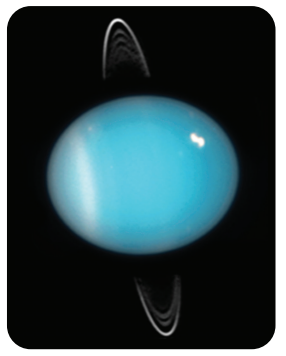- Practical exercise 1 Making models of the objects of the Solar System
- Practical exercise 2 Model the motion of Earth around the Sun
- Practical exercise 3 What are the distances of planets from the Sun?
- Practical exercise 4 What are the planets’ sizes?
- Practical exercise 5 When observing from Earth, why can we see the tilting of Saturn’s rings?
- Practical exercise 6 Model the motion of Uranus around the Sun and describe how seasons change for var-ious hypothetical positions of an observer on the „surface“ of Uranus.
Practical exercise 6: Model the motion of Uranus around the Sun and describe how seasons change for var-ious hypothetical positions of an observer on the „surface“ of Uranus.
Aids:
• models of the Sun and Uranus (see section a), pin with a coloured round head, strong source of light
Instructions:
1. Place the model of the Sun in the middle of the table. Place the model of Uranus about 20 cm from the Sun.
• Find in the charts how long it takes Uranus to orbit the Sun.
• Demonstrate the motion of Uranus around the Sun. Remember to keep the direction of Uranus’ axis in the space.
• Find out how “seasons” change in the north and south poles on Uranus. You can use the source of light to help you.
• Determine the period of tilting of Uranus’ rings.
• By inserting a pin into the surface of Uranus, mark a fictious observer on the 45th degree of uranography latitude. Move Uranus slowly on its orbital trajectory around the Sun and in each position make Uranus’ rotation about its axis. From the experiment draw conclusions what day and night look like in individual positions. Also find out how “seasons” change for such an observer.
• On the Uranus model, move the pin, showing a position of a fictious observer, to the equatorial. Again, move Uranus slowly on its orbital trajectory around the Sun and in each position make Uranus’ rotation about its axis. From the experiment draw conclu-sions what day and night look like in individual positions. Also find out how “seasons change” for an observer on equatorial.

(source: http://hubblesite.org/newscenter/archive/releases/2007/32/image/c/)


